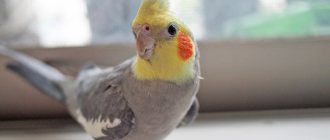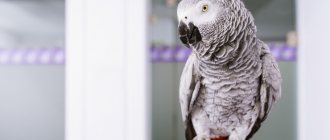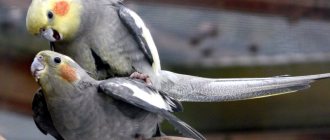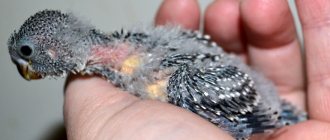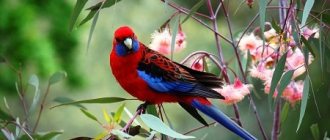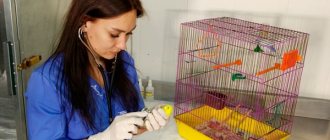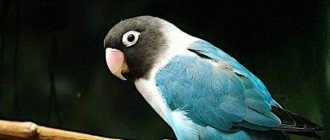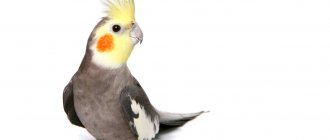The eyes of a parrot are a very important organ that helps birds easily navigate the space around them.
At the same time, it is worth immediately focusing your attention on the fact that the vision of birds is structured somewhat differently than that of humans. Surely you have noticed more than once that your ward easily navigates during his flight, skillfully maneuvering between moving people and at the same time choosing a place to land.
In addition, while eating delicacies offered by people, parrots constantly inspect the entire space around them. After all, only thanks to their observation skills, birds living in the wild can avoid meeting a predator sneaking up on them and fly away.
However, like other living creatures, the eyes of feathered pets can suffer from a number of threats, some of which we will list in the following article.
Inflammatory processes
It is not for nothing that we have placed various inflammatory processes in the first place on the list of circumstances dangerous to a pet’s eyes. After all, they can be caused by completely different factors, which every bird breeder should be aware of.
If there is at least one smoker in your family and he does not bother to get ready and go outside or onto the balcony to smoke, then most likely it is very smoky in your apartment.
Let’s not talk now about the dangers of smoking for people, because we are not talking about them, but about small and defenseless birds, who perceive tobacco smoke much more painfully. It is this that often becomes the reason that your feathered charges, for no apparent reason, begin to get red and inflamed eyes.
Can they see in the dark?
Can an ordinary parrot see in the dark? This is the second most frequently asked question. The Corella parrot or budgerigar, bred in captivity, unlike their wild counterparts, goes blind when it gets dark. They stop noticing anything already at dusk.
Birds learn about the world through their eyes; this is their source of information. As soon as it gets dark, they begin to have difficulty distinguishing objects, stop orienting themselves and go to sleep. If you leave it in a room without lighting in winter, the tropical bird will fall asleep at sunset.
Be sure to cover the bird's cage. His eyes are very sensitive to light. A sharply switched on lamp will frighten and disorient your overseas friend.
Foreign body
Surely you yourself have often gotten some kind of midge or speck into your eye. All of them evoke a persistent desire to remove them from the eye. Without thinking about the consequences of the fact that you begin to strongly rub the eye that is bothering you.
When a parrot encounters a similar phenomenon, it, just like other living beings, tries at all costs to get rid of the speck that has gotten into its eye.
Observing this from the side, you can see how the bird is intensely itching against the twigs or trying to get rid of irritation in some other way accessible to birds. Moreover, this often leads to the fact that the eye turns red and an inflammatory process begins in it, as in the case of colds. It often happens that birds' third eyelids swell and fall out.
Are the colors different?
Looking at the bright and beautiful colors of birds, I want to know whether parrots distinguish colors? And how! Your pets can recognize many more colors than humans.
Four types of cells are responsible for the perception of colors in birds; we have only three.
Extraordinary abilities
Millions of shades are available to us, but still we are not able to see the palette of colors that parrots see. They have the ability to see in ultraviolet light. It is not at all clear how our little pet picks up this range. It is known for sure that this feature affects their health. They need sunlight. If there is not enough daylight hours, then problems with their well-being will arise:
- They become lethargic, ruffled, and apathetic.
- Normal bone growth stops due to lack of vitamin D.
- Vision decreases so much that birds stop noticing colors, and the world around them appears in black and white.
To prevent such sad consequences, it is necessary to install an ultraviolet lamp; it will compensate for the lack of sunlight. This device will be useful if you want to breed tropical birds, for example, budgies or cockatiels.
Some interesting facts about parrot vision
Be sure to pay attention to some interesting facts about the vision of budgies. They are considered shy birds. They can be very frightened by the sudden movement of objects, especially when they suddenly disappear and appear in another place.
It is not advisable to constantly look your pet in the eyes at first. He may get very scared and see you as a potential predator. And this can scare away the bird and cause him great fear.
If the wavy has been living at home for quite a long time, then on the contrary, he needs to constantly look into the eyes. It is this contact that is important to them. It brings you closer, makes it clear to him that you are his friend. At the same time, do not forget to talk to him kindly.
During the process of evolution, feathered pets, when kept at home, completely lost night vision. They can only see in daylight. For this reason, they prefer to sleep at night.
What kind of vision do parrots have? It is sharp and precise and can react strongly to even small changes. For this reason, if you suddenly turn on the lights in the room while the bird is sleeping, it can greatly frighten it. It’s better to make a little noise first, and only then turn on the light.
The vision of budgerigars is an important function that ensures its full existence. The bird perceives even the slightest changes in space and reacts sharply to them. In order for your pet to feel comfortable, it is better not to make sudden movements or frighten him, he must first get used to you and the environment. If you liked the article or have something to add, leave your comments and also join our VKontakte group.
Varieties of colors
To control the breeds of budgerigars, the World Budgerigar Organization was created, the standards of which determine the classification of colors. According to the Standard, a parrot with feather streaks is considered normal. Breeding uses a combination of four factors:
- dark;
- brightening;
- grey;
- violet.
Various combinations of shades influence the appearance of more and more new colors.
Standard color
The traditional color is light green: these feathers cover the lower part of the parrot's body (chest, belly, undertail). The back and wings are much darker, and are decorated with a black wave pattern. The longest tail feathers on the tail are blue. The crown, facial mask and throat part are light yellow. Symmetrically located dark spots on the sides of the beard. There are purple markings under the eyes.
Standard color
Opaline coloring
These are the birds in the blue and green rows of the Standards table. Features of birds with this coloring:
- There are no clear stripes on the back;
- The uniform shade of the face mask gradually fades into a blurred pattern on the back of the head;
- On the wings, black markings cover the white pigment.
Opaline parrots become breeders to produce rainbow chicks.
Spangle or star coloring
Australian birds with an original inverted pattern were bred in 1974. This type of budgerigar was called “spangle” - bugles translated from English. The second name is “star-shaped”. A lace pattern on the tail and wings, the bulk of the feathers are white or yellowish with a dark frame. The body looks pale and the pattern resembles marble. In the Standards plate, lace color refers to the blue and green positions. This mutation is a phenomenon: it contains a place for a brightening agent, without which a two-factor spangle is impossible.
Spangle
Cinnamon
Signs of the species:
- Brown color instead of black;
- Coloration is sex-linked - males have darker markings than females;
- Chicks have violet eye color.
Cinnamon-colored parrot Pastel
colors and silky plumage make cinnamon-colored birds very attractive. They should not be confused with brown-winged parakeets, which are very rare.
Yellowface
Types of Yellow-faced Parrots:
- Single factor. Lemon mask. Yellow is mixed into the tail feathers, but does not extend to the remaining white areas of the body. Two-factors do not have a bright face mask.
- The yellow color of the mask is also an addition to the main plumage. The result is a diluted shade: not green feathers, but turquoise. Not blue, but dark green. Not lilac, but olive.
Yellow-faced Parrot
Most representatives of the species are completely covered with yellow feathers, but there are individuals only with a lemon-colored facial mask.
Greywing
It can be said about these birds that they are distinguished by one feature - gray wings. The rest of the body is painted in any color, bright or lightened, and the waves are dark gray, indistinct, slightly blurred.
Grey-winged budgie
Lyutino
Lutinos are obtained from green series producers. They are yellow, like egg yolk. There is absolutely no black pigment, just pure yellow and white feathers. There are small spots on the cheeks that shimmer with mother-of-pearl. Paws are pink. Most often, the lutino color is found in females, but there are also male lutinos if they receive this gene from both parents.
Lyutino
Albino
A white budgerigar bred by crossing blue birds. A characteristic feature is the absence of gray and blue plumage. The bird has pale pink legs, like lutino's, and red eyes. The color is gender-linked.
Albino
Clearwing
Judging by the name, we can conclude that a clear-winged parrot should have wings painted in a pure shade, uniform, without foreign inclusions. Individuals in the blue classification column are blue, purple, gray or blue. They are united by one factor - white flight feathers and the base of the back. Other parts of the body are full color.
Clear-winged budgie
If the bird is greenish in color, then its wings are yellow. Most often, the pattern on the wings is still present, but it is only slightly visible. The tail is paler than that of differently colored birds.
Variegated colors
Variegated budgies are birds with colorful spots on their bodies. The markings may be multiple or one large spot, for example, on the back of the head. The pigment is suppressed in random order. The result is an indefinite pattern, interrupted by white, green or yellow marks. These parrots are small in size.
Half coloring
The hybrid breed, which appeared in Denmark, received the colloquial name “Harlequin”. A bird with half coloring looks very impressive: its body is divided by color into two approximately equal parts. This can be a vertical division or a horizontal one. The crop is yellow and the abdomen is blue. Or, for example, the left side of the sternum and abdomen is green, and the right side is blue. Unusual coloring is not inherited. Among breeders, harlequins are considered special luck.
Half coloring
general information
The eyes of people and birds differ in location. If for us and all mammals they are located on the front part of the head, then for parrots they are at the edges. Therefore, they can provide a view of almost 360 degrees.
General information about how parrots see
Their visual apparatus consists of components:
- eyelids (lower and upper);
- tear duct;
- eyeballs (their anterior shell is covered with the cornea, behind it there is a lens, which has a different color of the iris).
If we compare the ratio of eyes to body volume, then birds are larger than humans. But that doesn't mean they see much better.
The perception of the world itself is also different. If a person focuses his attention on only one object, then birds can focus his attention on 2 things at once. Therefore, it is almost impossible to take them by surprise.
Causes of development of inflammatory eye diseases
Clinicians identify the main etiological factors of eye diseases
:
- contact of an infectious agent (virus, bacteria, fungi) on the surface of the conjunctiva with dirty hands, when swimming in contaminated bodies of water;
- hematogenous spread of pathogenic microorganisms from foci of chronic infection;
- prolonged exposure to ultraviolet radiation (including “snow blindness”);
- allergic reactions to medications, pollen;
- eye fatigue, constant work at the computer;
- injuries, ingress of foreign objects;
- irritating effects of smoke, atmospheric pollutants, chemical reagents.
Causes of eye disease
Less common causes of eye disease
: long-term wearing of contact lenses, metabolic disorders, vitamin A deficiency, endocrine diseases, atherosclerotic and other vascular lesions of the eyeball.
Treatment and prevention of eye diseases
Self-medication for eye disease in a parrot is ineffective, sometimes even leading to death.
Do not self-medicate. Contact an ornithologist. Let the veterinarian prescribe drops, ointments, or do all the procedures himself if you are afraid. Of course, the Internet is full of recipes for “homemade drops” based on vitamin A or boric acid. But what if the parrot has an infection? It must be eliminated with the help of antibiotics, fungicides, and antiviral drugs. Simple drops will not help in such a situation. They are effective only when conjunctivitis is of non-contagious etiology, caused, for example, by dust.
If we talk about prevention, then, first of all, do not place the bird’s cage in places where there are drafts. Or there is a possibility of contact with strong odors (tobacco smoke, ammonia, hydrogen sulfide). The kitchen is not the place for a bird cage. Be sure to monitor the parrot's condition. At the first symptoms, seek help from a specialist.
Do not put a newly purchased or given new bird in your parrot's cage. Must undergo a month of quarantine. This is to prevent reinfection of feathered pets in your home.
What kind of vision do budgies have?
Birds' eyes are located on the sides of their heads. It is for this reason that their viewing angle is 360 degrees. Their vision is monocular, which means that parrots are capable of seeing several images with different eyes.
Their eyes move separately from each other. They can at one time linger on certain objects that are located in different places. For this reason, the sudden disappearance of an object and its reappearance in another place can greatly frighten the bird. When you arrive next to your pet, it is better not to make sharp or sudden movements.
The eyes of wavy birds occupy about half the volume of their head, this is due to their complex structure. The visual system includes the following parts:
- Eyelids;
- Tear ducts;
- Eyeballs.
The visual system is connected to the brain by the optic nerve, which transmits important electrical signals. The lens is an important structural element of the eye; it is required for the necessary focusing on objects.
Blindness
Deterioration and even loss of vision is often caused by the aging of the bird and is considered a consequence of natural processes occurring in the body. But blindness is often caused by other factors. These blinding factors may be:
- injuries;
- consequences of past illnesses;
- and so on.
Usually a blind parrot does not open its eyes. If the parrot is already blind, there is hardly a chance of restoring his sight. Therefore, treatment therapy should be started on time, when the disease has not yet taken over the body of the feathered pet.
What can a parrot see?
How does a little budgie see the world? Parrots' vision has a complex structure. The bird's brain has more neural connections with the organs of vision than mammals. Birds' eyes are located on the sides of their heads.
Features of vision
Thanks to this arrangement, the bird has an almost all-round view of 340°. They move independently and focus on completely different objects. This monocular vision allows you to distinguish different pictures. A bird cannot see the same thing at the same time. To look at an object, she has to tilt her head and focus with one eye. A movable neck helps him with this. It can rotate 180°.
How are we different?
A feature of tropical birds is the speed of frame perception, it is much higher than that of a person - 150 frames per second versus 24. This is clearly visible when watching TV shows or films. All of them transmit images at 24 frames per second. If you sit down to watch TV, your pet will not be with you; for him, the action happens very slowly.
You don’t suspect it, but within a few seconds, flying around the room, the budgerigar saw everything that could interest him. Where are you, where is his food, cage, toys, where is the best place to sit and are there any cats in the room.
The specific way parrots process visual information helps them spot danger in time.
Xerophthalmia
This disease is caused by the lack of vital substances in the pet’s body, in particular vitamin A. But the causes of the disease cannot be ruled out by the negative impact of chemical substances on the visual organs. The essence of xerophthalmia lies in the following manifestations:
- sudden loss of visual acuity;
- blurred vision.
The disease must be treated immediately. Therapy is based on the bird undergoing a special course of medication and taking vitamin and mineral supplements. The specific treatment is prescribed by the veterinarian.
What bird has brown eyes?
If you come across a bird with brown eyes, it is most likely a predator. Wild birds that hunt mice and small rodents are usually brown-eyed. One of these birds is the buzzard. It lives in forests, settling at a height of up to 15 meters above the ground. Its color is always dominated by brown colors of various shades, depending on the species.
Everyone knows a bird with brown eyes, like an owl. This predator lives in forests, inhabiting hollows, and is nocturnal. Her appearance is unique and amazing. The color of feathers can be of various shades, ranging from white to black. It depends more on where it lives and the nature surrounding it. Looking at her, you might think that she has no neck. The body immediately goes into the head - its plumage is so lush.
The owl's feet have very sharp claws. With them she catches prey and carries it to her hollow. Its beak is small, pointed and hook-shaped. Its peculiarity is its large round eyes. Her eyeballs cannot rotate at all, but her head can rotate 270 degrees.
What bird has green eyes?
The most popular bird with green eyes is the wild duck. It settles in bodies of water, near reeds or other vegetation along the shore, where it lays eggs. She spends almost all her time in the water; in winter she chooses ponds and lakes that are not covered with ice. A bird with green eyes also has this color in its plumage. It is especially pronounced in males, whose heads are painted with turquoise down up to their necks.
Nowadays, one bird with green eyes is known to everyone as the bittern. She prefers to live in swamps and feeds on carrion, frogs, and mice. Its feathers are brown in color, which is evenly combined with patches of darker and lighter shades.
